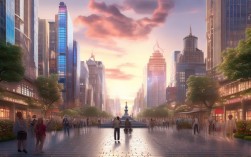在众多备战的雅思口语话题中,“a beautiful city”是一个高频且开放性较强的题目,考生若想在此话题中脱颖而出,不仅需要掌握描述性词汇和句型,更要构建有逻辑、有细节的叙述框架,本文将从城市的美学特征、文化氛围、生活体验三个维度展开,并提供实用的表达策略,帮助考生从容应对这一话题。

城市的美学特征:自然与建筑的和谐
一座城市的美丽,首先体现在视觉上的和谐感,在描述时,可以从自然景观和建筑风格两方面切入,若提到海滨城市,可强调“golden beaches stretching along the coastline”和“crystal-clear water reflecting the sunlight”,营造明快清新的画面;若谈论历史古城,则可聚焦“ancient stone-paved streets”和“traditional architecture with curved eaves and wooden carvings”,突出岁月沉淀的韵味。
考生需注意避免泛泛而谈“beautiful”或“nice”,而是通过具体细节让描述生动化,描述公园时,可加入“rows of cherry trees in full bloom during spring”或“children flying kites on the vast lawn”这样的动态场景,让考官仿佛身临其境,对比手法能有效增强说服力,如“the modern skyscrapers in the financial district stand in harmony with the old-town temples, creating a unique skyline”。
文化氛围:历史与现代的交融
文化是城市的灵魂,也是描述“beautiful city”时不可或缺的维度,一座富有魅力的城市,往往能在保留历史底蕴的同时,展现出蓬勃的现代活力,可提及“local museums housing thousands of cultural relics”或“annual traditional festivals where citizens wear colorful costumes and perform folk dances”,展现文化的传承;可补充“art galleries displaying contemporary works”或“innovative tech parks attracting young talents”,体现城市的与时俱进。
在表达上,可使用“not only...but also...”结构连接传统与现代,如“The city is not only a guardian of ancient traditions but also a hub of modern innovation”,引用具体案例能让描述更具说服力,The Grand Theater, designed by a world-renowned architect, hosts opera performances that attract audiences from all over the globe”。
生活体验:人与城市的温暖互动
城市的美丽,最终体现在居民的生活状态中,一个宜居的城市,往往拥有便捷的交通、完善的服务和友善的社区氛围,考生可描述“wide sidewalks lined with cozy cafes”或“efficient metro system connecting every corner of the city”,展现便利性;也可通过“neighbors chatting in the community garden”或“volunteers helping elderly people cross the street”等细节,体现城市的温情。
数据或具体事例的引用能提升描述的可信度,据调查显示,“over 80% of the city’s residents are satisfied with the public green space per capita”,或“the city has been awarded the ‘Most Livable City’ title for five consecutive years”,使用感官词汇(如“the aroma of fresh bread from local bakeries”或“the sound of street musicians playing melodious tunes”)能让生活场景更加鲜活。
实用表达策略与词汇储备
为帮助考生更好地组织语言,以下分类整理了高频词汇和句型:
| 类别 | 词汇/句型示例 |
|---|---|
| 自然景观 | picturesque scenery, lush greenery, tranquil lake, breathtaking sunset |
| 建筑风格 | modern architecture, historic landmarks, Gothic cathedral, skyscraper, boutique |
| 文化氛围 | rich heritage, vibrant art scene, traditional customs, cultural diversity |
| 生活体验 | convenient transportation, lively neighborhood, high quality of life, friendly locals |
| 连接词 | besides, moreover, in addition, what’s more, as a result |
| 高级句型 | It is the...that makes the city unique. / The city captivates visitors with its... |
FAQs
如何在回答中避免内容重复?
可通过切换描述角度来解决,描述“beautiful city”时,第一段聚焦视觉景观(建筑、自然),第二段转向文化体验(历史、艺术),第三段深入生活细节(社区、日常),每段使用不同主题词汇和案例,确保内容丰富且不重复,灵活运用时态(如现在时描述现状,过去时回忆历史)和句型(如倒装句、强调句)也能提升表达的多样性。
如果没有亲身经历,如何虚构细节而不显虚假?
基于合理想象进行细节补充,关键在于“具体化”而非“夸张化”,若描述公园,可虚构“there is a small pond where ducks swim gracefully,and children enjoy feeding them with breadcrumbs”,这样的细节符合常识且自然;避免编造不存在的地标或数据(如“the tallest building in the world”),以免引起考官怀疑,使用“it is said that...”或“according to local residents...”等模糊表述,可增强细节的可信度。











